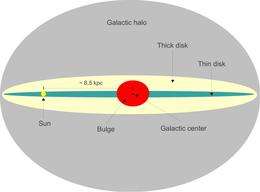Thin disk

The thin disk is a structural component of certain galaxies. The Milky Way's thin disk is thought to extend up to ~350 parsecs (1,100 ly) in the vertical axis[1] and contributes about 85% of the stars in the Galactic plane.[2] It can be set apart from the thick disc of a galaxy since the latter is composed of older population stars created at an earlier stage of the galaxy formation. Stars in the thin disk, on the other hand, are created as a result of gas accretion at the end stage of a galaxy formation.
The thin disk contains stars with a wide range of ages and may be divided into a series of sub-populations of increasing age. Notwithstanding, it is considered to be considerably younger than the thick disk.[3]
Based upon the emerging science of nucleocosmochronology, the Galactic thin disk of the Milky Way is estimated to have been formed 8.8 ± 1.7 billion years ago.[4]
See also
External links
- Astronomers identify thick disc of older stars in nearby Andromeda galaxy
- Populations & Components of the Milky Way
References
- ↑ Bradley W. Carroll and Dale A. Ostlie, 2007, "An Introduction to Modern Astrophysics" Second Edition
- ↑ Carlos Allende Prieto (Nov 2009). "The Stellar Population of the Thin Disk". Proceedings IAU Symposium (265). arXiv:0911.3598
 .
. - ↑ Bensby & Feltzing, "The Galactic thin and thick discs in the context of galaxy formation",
- ↑ Eduardo F. del Peloso a1a, Licio da Silva a1, Gustavo F. Porto de Mello and Lilia I. Arany-Prado (2005), "The age of the Galactic thin disk from Th/Eu nucleocosmochronology: extended sample" (Proceedings of the International Astronomical Union (2005), 1: 485-486 Cambridge University Press)